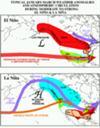- Air Homepage
- Weather Equipment
- Mathematics Used in Meteorology
Example of mathematics used in meteorology
You may ask, "what about the mathematics used in meteorology?" Many people wonder how math relates to meteorology.
Modelling the atmosphere: The math behind the weather - Ever wonder how a meteorologist sees wind in three dimensions or how computers predict storms based on just temperature and pressure? Learn how to model the entire dynamic atmosphere using the powerful mathematics of meteorology, from basic variables to complex Navier-Stokes equations.
Math and weather have always been two of my favorite subjects. Math helps me understand the world around me, and weather is just fascinating. Temperature, pressure, and wind interact to create the weather we experience.
Does meteorology require math skills? It can't hurt - that's for sure.
The science of meteorology relies heavily on math and physics. You can use weather radar, interpret charts (like the hodograph on the right), and predict the weather numerically. The sketch shows five simultaneous winds speeds at a single geographical point, each at a different elevation above ground.
Meteorologists study the atmosphere. Among other things, they look at and predict the weather and air pollution.
We also use instruments to measure wind speed and direction, temperature, pressure and humidity. We can then understand how these different quantities, sometimes called fields, interact with each other with scientific theory. And how the variables change in time and space.
Variables are unspecified quantities that can take on different values under different conditions.
In math, we use the letters x and y for most problems. Mathematicians use them to determine or assign specific values to variables based on the circumstances of the problem.
Basic mathematics used in meteorology
Variables for the mathematics used in meteorology include:
- T for temperature, often qualified with a subscript to denote specific temperatures,,
- P for pressure in millibars,
- θ (a Greek letter, theta), which looks like a zero with a horizontal dash, represents
potential temperature.
That is, the temperature a package of air would change to if suddenly compressed to 1000 millibars without gaining or losing any heat,
- u and v for vector quantities for horizontal velocities of varying types. Alternatively, they can represent vector components of a single velocity and be combined with w, vertical velocity, to make a three-dimensional wind field,
- ρ (the Greek letter rho), which sometimes resembles a backwards 9, to mean density, a function of pressure, temperature and composition,
- Humidity is the biggest variable in composition. RH stands for relative humidity, and either a lower case r or q represents the mixing ratio, a measure of absolute humidity.
Meteorology is a three-dimensional science, four if you include time, so the mathematics can require partial derivatives a lot. What's that? You can use partial derivatives to see how something like wind speed changes when you move in one direction only, like straight north. Pilots might find this useful. We can also figure out the gradient of a field with them. For instance, figuring out what direction to move in to see the biggest temperature increase. Even how much it increases after moving a certain distance.
The mathematics used in meteorology could, and does, fill textbooks quite extensively. Atmospheric Science - An Introductory Survey by Wallace and Hobbs and An Introduction to Dynamic Meteorology by James R. Holton are good starters Go Nuts!
I just about did.
A centripetal force equation, for example, relies on balancing physical properties. Then each force is defined by products and derivatives of other parameters. Then they're strung along as terms added together, each a component of the net force. Sometimes, but not always.
What other fields of study use the same mathematical principles? Physics, climatology, hydrology, and atmospheric chemistry.
Weather forecasting dates back to ancient times, when people used observations of the sky and natural phenomena to predict the weather. We got better though.
Meteorologists have developed sophisticated computer models and technologies to create increasingly accurate weather forecasts since they started using scientific methods in the 1800s.
Meteorology Computers
What's math without a few computers? Lewis Fry Richardson wrote Weather Prediction by Numerical Process in 1922. He proposed that we could simplify meteorology math by looking at small parametric changes with respect to small physical motions instead of these abstract equations. Thus, simple algebra could help us explain the complex principles.
It was labor-intensive, though. With this primitive method, 64000 people would be needed to make the calculations to predict the world's weather. His results were also pretty poor.
Little did he know about computers to be invented just a few decades later. They would really help with the mathematics used in meteorology. In the mid-20th century, computers revolutionized weather forecasting by allowing scientists to input huge amounts of data and do complex calculations. In order to simulate the behavior of the atmosphere and make detailed forecasts, numerical weather prediction (NWP) models were developed. They made Richardson's calculations go more efficiently.
They've improved since then, believe it or not. We rely on models a lot now. Meteorologists had more data to work with in the 1970s and 1980s with weather satellites and other advanced technologies. The most advanced weather forecasting models today use data from satellites, weather balloons, and ground-based sensors to make highly detailed and accurate forecasts up to a few days in advance.
Because they've incorporated things like chaos theory and can give ensemble forecasts, which allow for changing probabilities and small changes in statistics. We will continue to develop more sophisticated technologies and mathematics used in meteorology to predict the ever-changing patterns of the atmosphere.
As such, the history of weather forecasting is an ongoing story of innovation and improvement. It just keeps getting better. Thanks to the mathematics used in meteorology.
Mathematical Examples
To predict weather patterns, analyze data, and understand weather systems, meteorologists rely on mathematics. Here are some examples of how math is used every day:
- Models are used to predict the paths of storms. They use variables like wind speed, atmospheric pressure, and temperature. One of the fundamental equations is Navier-Stokes to describe the motion of fluids. Navier-Stokes equations use momentum and mass conservation in fluid dynamics and with these equations, we can simulate how air moves.
 Models of the environment
Models of the environment- We use satellite data to study Earth's atmosphere. With algorithms such as Fourier transforms to interpret raw image data, meteorologists can analyze images and identify cloud patterns and other features in the atmosphere.
- Forecasting with Bernoulli's equation: Bernoulli's equation is another meteorological tool. Pressure, velocity, and height are related to moving fluids. Bernoulli's equation explains wind speed variations and pressure changes.
- Numerical Weather Prediction: NWP simulates the atmosphere and predicts the weather. These models solve Navier-Stokes equations, thermodynamic energy equations, and continuity equations. These equations help forecast the weather
We are NOT Geeks
At least that's what some people think. Do you think math helps us to understand our world? Succeed at work? Use a computer?
You bet. That reminds me, it can help make you a better gambler if you're so inclined.
What's the most important thing math helps you with?
What Other Great Mathemeticians Have Said...
Click below to see contributions from other visitors to this page...
The Four Leaved Rose 




Trace directly from Storm B to A to C; then To Sitorm D to F to E; then to Storm G and out over Lake Michigan; then to Storm J to K to L and finally M. …
School 




Math is very helpful in school. Of course it helps me in Algebra, but it also helps me in other classes. Like in Science.
The teacher tells us the …
wind diagrams 




HOW DO ONE DRAW A WIND ROS AND what is the function of these wind diagrams?
Barry's Response - Kelvin:
Want to learn more about the intricate …
Hydrology Consulting 




I have a new hydrology consulting idea. I am a civil engineer specializing in computer modeling of hydrologic phenomena. My primary interest is in finding …
We are, in fact geeks Not rated yet
Disregard the above statement, we will go out of our way to make something mathematic.
Barry's Response
Why would someone do that? Here's a few …
why maths Not rated yet
I really want to be a meteorologist but the fact is i am very bad at mathematics and i cant murder myself to do pure maths Barry: short for mathematics …
We all use math everyday Not rated yet
People don't realize how often math comes up on a daily basis. Not just by making calculations but logical reasoning. I was in a map analysis class and …
Examples of the mathematics used in meteorology - What is the importance of mathematics in meteorology?
Here are some examples of the mathematics used in meteorology. An introduction to variables, equations, and numerical weather prediction.
Do you have concerns about air pollution in your area??
Perhaps modelling air pollution will provide the answers to your question.
That is what I do on a full-time basis. Find out if it is necessary for your project.
Have your Say...
on the StuffintheAir facebook page
Other topics listed in these guides:
The Stuff-in-the-Air Site Map
And,
Thank you to my research and writing assistants, ChatGPT and WordTune, as well as Wombo and others for the images.
OpenAI's large-scale language generation model (and others provided by Google and Meta), helped generate this text. As soon as draft language is generated, the author reviews, edits, and revises it to their own liking and is responsible for the content.












New! Comments
Do you like what you see here? Please let us know in the box below.